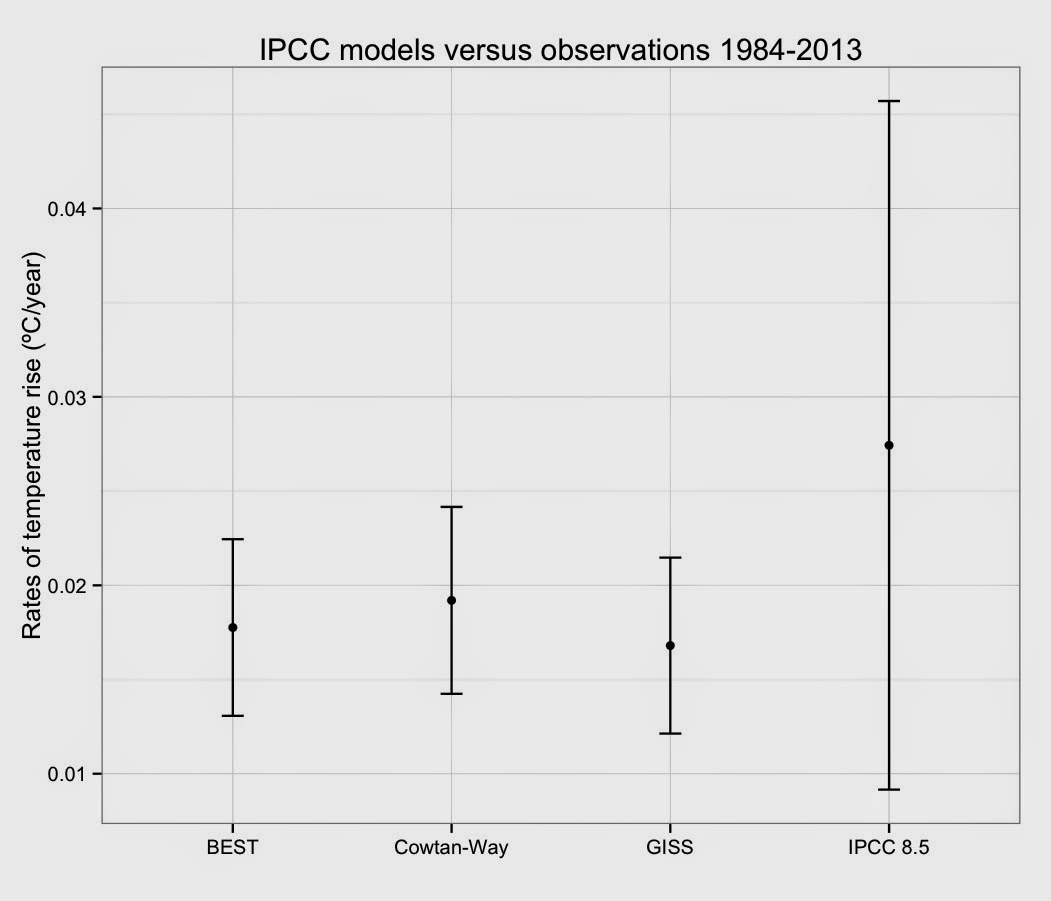IPCC models versus actual trends
This is an extension of my previous post comparing IPCC models and actual temperature data. I had a request to directly compare the observed rates of temperature rise with the predicted rise from the average of the AR5 models. First, my methods: I averaged all 81 IPCC AR5 8.5 models. I then calculated the rate of change for the average of the models as well as Berkeley Earth's Land + Ocean dataset, the new Cowtan-Way coverage-corrected version of HadCRUT4, and GISS. All rates were calculated after compensating for autocorrelation. With that out of the way, here's the rates of temperature rise for the last 30 full years (1984-2013) in three surface datasets that cover the entire globe versus the average of all 81 IPCC AR5 8.5 scenarios:
While the average rate from the IPCC AR5 8.5 models is higher than the observations, the observations are well within the 95% confidence interval. The difference in the rates is not statistically significant.
The true test of the AR5 models, however, is their accuracy since January 2000. That's the start of the actual predictions. That also poses a problem for determining whether or not the models are accurate. It's only been 14.58 years since January 2000. You need over 17 years to reliably detect actual climate trends in temperature data (Santer et al. 2011), making comparisons since January 2000 largely meaningless as the following graph shows.
Notice the massive 95% confidence intervals around the observed trends? The observed trends could be anything from less than -0.01ºC/year to over 0.03ºC/year. That range easily contains the average trend calculated from the IPCC AR5 models. So while it appears that the predicted average trend is far higher than the observed trends, the reality is that there's no statistical difference between the predicted and observed trends. And while I'm at it, there's also no evidence that global warming has stopped or even really slowed—just look at that possible range around the observed trends.
The reality is that right now, there is no statistical basis to determine if the IPCC AR5 models are wrong, even without accounting for random climate events like ENSO, volcanic eruptions, or changes in solar output. Published research shows that just accounting for ENSO alone explains much of the discrepancy between the predicted trends and the observed trends (i.e. Kosaka and Xie 2013, Risbey et al. 2014). The upshot of it all is that those proclaiming that the models are wrong are either greatly exaggerating or simply ignoring the evidence in favor of a simplistic and wrong view of how the world works.
 |
| Rate of temperature increase between 1984 and 2013 for IPCC AR5 models (8.5 scenario) versus Berkeley Earth Land + Ocean data, Cowtan-Way |
The true test of the AR5 models, however, is their accuracy since January 2000. That's the start of the actual predictions. That also poses a problem for determining whether or not the models are accurate. It's only been 14.58 years since January 2000. You need over 17 years to reliably detect actual climate trends in temperature data (Santer et al. 2011), making comparisons since January 2000 largely meaningless as the following graph shows.
Notice the massive 95% confidence intervals around the observed trends? The observed trends could be anything from less than -0.01ºC/year to over 0.03ºC/year. That range easily contains the average trend calculated from the IPCC AR5 models. So while it appears that the predicted average trend is far higher than the observed trends, the reality is that there's no statistical difference between the predicted and observed trends. And while I'm at it, there's also no evidence that global warming has stopped or even really slowed—just look at that possible range around the observed trends.
The reality is that right now, there is no statistical basis to determine if the IPCC AR5 models are wrong, even without accounting for random climate events like ENSO, volcanic eruptions, or changes in solar output. Published research shows that just accounting for ENSO alone explains much of the discrepancy between the predicted trends and the observed trends (i.e. Kosaka and Xie 2013, Risbey et al. 2014). The upshot of it all is that those proclaiming that the models are wrong are either greatly exaggerating or simply ignoring the evidence in favor of a simplistic and wrong view of how the world works.




Comments
Post a Comment